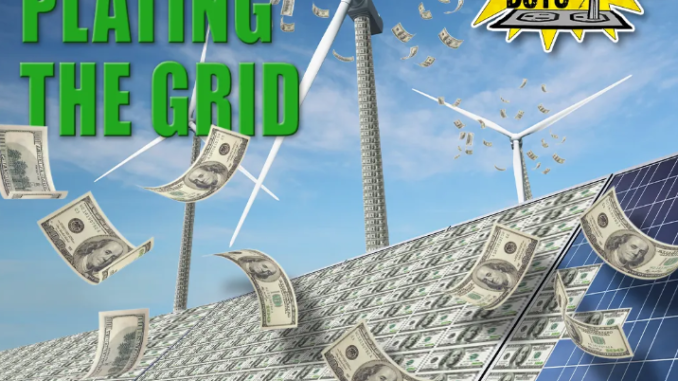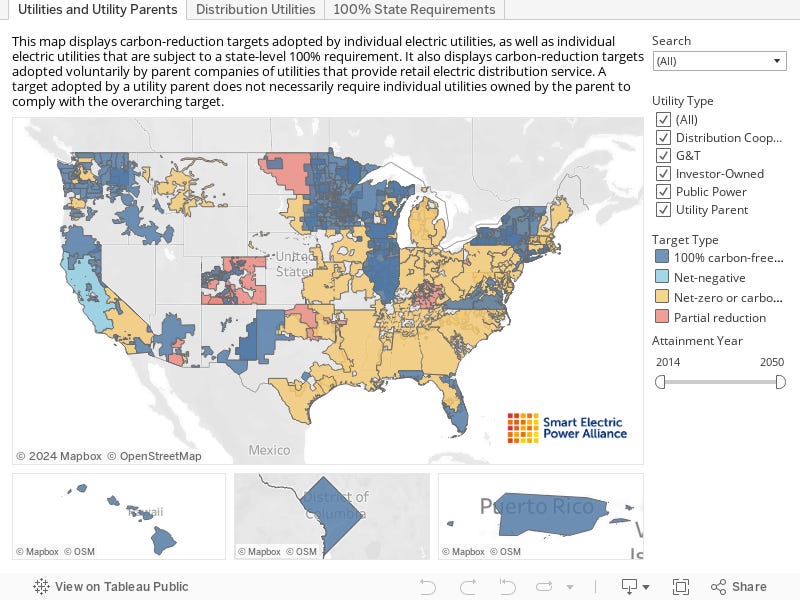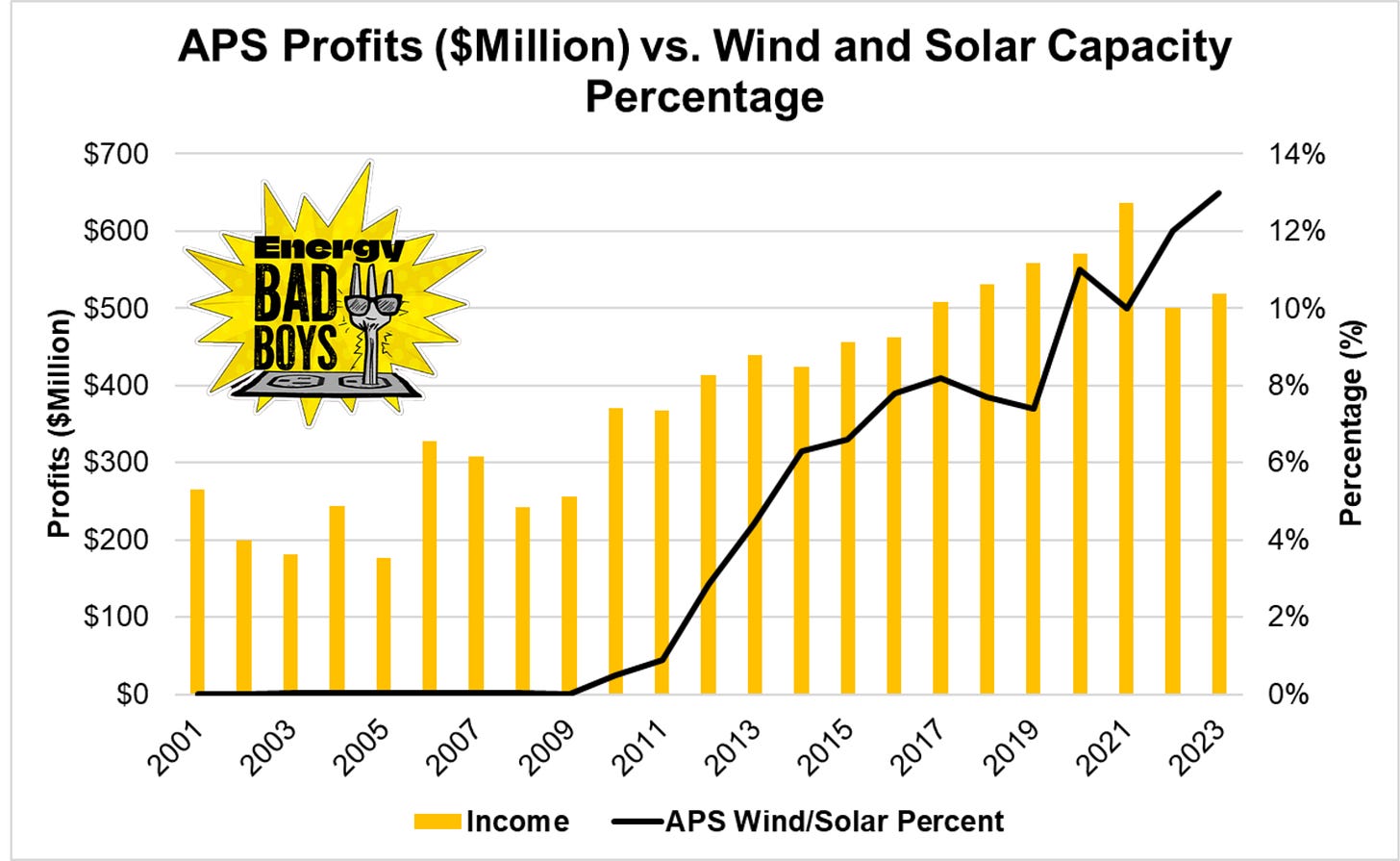
ENB Pub Note: This article is from the Energy Bad Boys Substack! I have invited them on the Energy News Beat podcast and am getting it scheduled. We recommend subscribing and supporting them! Tell them Stu sent you.
Vertically integrated Investor-Owned Utilities (IOUs) across America are raking in record-breaking profits under the guise of the so-called “energy transition.”
From 2014 to 2024, earnings for American electric utilities have more than doubled, growing at more than 15 percent per year for the last three years, largely due to surging spending on new wind turbines, solar panels, and natural gas plants.
These numbers are such a deviation from the slow-and-steady industry that electric utility companies are supposed to be that Morningstar had to ask in 2023, are “Utilities Suddenly A Growth Sector?” As Travis Miller explained in the article, the tremendous growth in earnings in the electric utility sector is driven by electrification efforts and renewable energy investments and likely will be for some time if the trend continues:
Utilities are never going to rival tech companies or biotech companies in terms of growth. But this is the best utilities growth environment that we’ve seen in decades. When you combine those big macro themes of electrification and clean energy, we’re seeing utilities with growth prospects that we haven’t seen in many, many, many years. And these aren’t just growth prospects for the next year or two. This is growth that we think can last for a decade or more. A lot of the clean energy goals and the electrification goals out there right now are 2040, 2050 goals. When you look at all of the infrastructure investment that’s needed to get to those goals, this is a long runway of growth for utilities, perhaps more so than any other sector.
Emphasis added.
The link between utility profits and capital spending is nothing new. Utilities are generally on board with efforts to support the so-called “energy transition” because it gives them the perfect excuse to build as much as possible, which is the primary way they earn profits.
Spend More Money, Make More Money: How Utilities Turn A Profit
IOUs may have investors, but they aren’t really private companies. They are government-approved, vertically integrated monopoly utilities with the exclusive right to sell electricity in their service territory.
Because customers have no choice but to buy their power from the monopoly, it would be unfair to let the company charge whatever it wishes for electricity. As a result, electricity prices are generally set by government regulators using a mathematical formula called the Cost-of-Service formula.
In its most basic form, the formula states that utilities are allowed to charge enough for their electricity to cover the cost of providing the service to everyone in their service territory, plus a government-approved profit, often five to ten percent, on their capital investments. As long as the expenses are approved by the regulator in their state, utilities make a profit on every dollar they spend on new builds such as wind turbines, solar panels, natural gas plants, or even renovating corporate offices.
The more money utilities spend, the more money they make.
On the other side of this equation is depreciation. Every year, the company pays off a little bit more of the plant, and as a result, they no longer profit from this depreciated capital expense. The graph below is a hypothetical power plant on a 30-year depreciation schedule. The utility makes a cool $11.25 million in corporate profits in the first year, but by year 31, the asset is entirely depreciated, delivering no returns for shareholders.

Once a power plant is paid off entirely, the utility no longer makes any profit from the facility. From the perspective of customers, fully depreciated power plants offer some of the lowest-cost sources of electricity on the grid. From the perspective of the utility, they’re no longer a means for growing earnings. As a result, utilities have a powerful financial incentive to work against the interest of their customers by retiring reliable, low-cost existing generators so they can spend as much money as possible building new infrastructure to put in their rate base, thus maximizing their government-approved profits.
The Averch-Johnson Effect: Green Plating™ The Grid
The desire for regulated companies to pursue non-productive and capital-intensive projects is now known as the Averch-Johnson Effect. This effect is also often referred to as “Gold-Plating,” based on the somewhat sarcastic idea that a regulated firm might plate its building and fixtures in gold simply because gold is more costly than other materials.
However, the latest wave of “Gold-Plating” has more of a greenish tint to it. In today’s version, wind and solar provide the inefficiencies utility companies are looking for. Utilities are now Green-Plating™ their grids, and the fact that wind and solar are unreliable is an incredible bonus because it means they get to retire depreciated assets and build far more capacity to replace them than would normally be necessary.
Let’s consider an example of retiring a 10-megawatt (MW) coal facility that is completely depreciated. Replacing this plant with wind and solar allows the utility to build 10 MW of wind, 10 MW of solar, and 10 MW of natural gas to provide reliable power during the inevitable periods when wind and solar are producing zero power.

This new grid allows utilities to spend $44.17 million and triple the installed capacity on their system with new, undepreciated assets to do the same job as the coal plant they just retired.
The graph below demonstrates the inefficiencies of replacing reliable coal facilities with a mixture of wind, solar, and gas. The graph uses 10 MW of demand as a proxy for coal generation. Hourly generation from wind and solar is based on recent conditions observed in the Midcontinent Independent Systems Operator (MISO), and natural gas fills in the gaps.

With the potential for windfall profits from building unreliable assets, it comes as little surprise that utility companies across America are making voluntary pledges to go carbon-free “for the planet.”
The map below from the Smart Electric Power Alliance shows utilities that have pledged to achieve 100 percent carbon-free, net negative, net-zero, or reduce emissions.

Unfortunately, these pledges are not isolated to states that have passed legislation mandating a phase-out of coal and natural gas plants in favor of wind, solar, and battery storage. Utilities around the country, in Red States and Blue States, are jumping on at the opportunity to get greener by going green.
Averch-Johnson in Action
The Averch-Johnson Effect isn’t just a theory, and you can see it playing out in the electric utility sector.
Whether it is due to state mandates for carbon-free electricity or good, old-fashioned profit-seeking by government-approved monopolies, there are numerous examples of utilities green-plating the grid, and we highlight several companies below whose profits have grown dramatically during the green energy movement.
Xcel Energy – Minnesota
Xcel Energy prides itself on being a national leader in wind energy since 2005. The company has service territories in several states, including companies in Colorado, Michigan, Minnesota, New Mexico, North Dakota, South Dakota, Texas, and Wisconsin.
Minnesota passed the Next Generation Energy Act (NGEA) in 2007, which mandated utility companies to achieve 25 percent of their electricity from renewable energy sources like wind and solar by 2025.
From 2001 to 2007, before the renewable mandates were enacted, profits for Xcel Energy in Minnesota grew by an average of 2.9 percent per year. Since 2007, profits have grown by 115 percent, increasing by an average 7.6 percent per year, driven largely by renewable energy investments.

Xcel couched these efforts in campaigns such as “Steel for Fuel,” which the company stated was a “growth strategy” that “delivers both economic and environmental benefits for customers and other stakeholders.”
We’re adding renewable resources—the steel—at a savings, where the capital costs of the projects are more than offset by the savings from renewable tax credits and avoided fuel costs. We also operate in some of the best regions of the country for wind and solar energy, resulting in projects with higher capacity factors that can produce more electricity.
So far, these “savings” haven’t been realized, and the capital costs associated with renewable investments have dramatically increased prices for Xcel customers. In 2001, according to data provided by the Energy Information Administration (EIA), electricity rates at Xcel in Minnesota ranked in the bottom half of utilities in the country and were 16 percent lower than the national average. In 2022, thanks to massive investments in unnecessary wind and solar facilities, they ranked in the top 25 percent and were 7 percent higher than the national average.
Wisconsin Electric Power Company (We Energies)
Not all energy transitions are created equally. Almost every case involves retiring coal plants prematurely. However, while some states, like Minnesota, built wind and solar heavily at the start, in Wisconsin, the so-called energy transition largely stemmed from prematurely retiring coal plants that had just installed expensive pollution control equipment and replacing them with new natural gas plants. The wind and solar were later added on top of the new natural gas capacity.
As you can see, as the percentage of wind, solar, and natural gas capacity owned by WE grew to over 30 percent, beginning in 2004, profits grew by 94 percent and averaged nearly 5 percent per year during that time.

WE Energies has increased its profits so much that wealthy Wall Street investors and analysts threw the former We Energies CEO Gale Klappa a fancy dinner party in midtown Manhattan and called him the “Wizard of Wisconsin” because We Energies’ profits grew faster than Berkshire Hathaway’s, the company run by Warren Buffet, the Oracle of Omaha.
While investors have been singing the company’s praises, customers have been left out to dry. Electricity rates at WE Energies were once 10 percent lower than the national average in 2001, providing the state with a competitive advantage over much of the country. However, as a result of Green-Plating the grid, WE Energies’ electricity rates were 7 percent higher in 2022, right behind Xcel Energy in Minnesota.
Arizona Public Service (APS)

DTE Electric
Michigan, similar to Wisconsin, began its energy transition by replacing coal with natural gas. However, profits for Michigan’s largest electric utility company, DTE Electric, really took off after the company started investing heavily in renewable energy sources like wind and solar after 2014. The company even used “environmental regulations” as part of its strategy for long-term earnings growth.
While profits for DTE Electric increased by a healthy 128 percent from 2001 to 2014, averaging just under 10 percent per year, they have increased by 162 percent from 2014 to 2024, averaging a whopping 18 percent per year.

This massive profit growth, driven primarily by investments in renewable energy sources, hasn’t served DTE Electric customers very well. Like Xcel and WE Energies above, DTE once had electricity rates on-par with the national average in 2001. By 2022, they were over 10 percent higher.
Conclusion
Utility companies are using the “energy transition” to Green Plate their systems by spending tens of billions of dollars on wind turbines, solar panels, battery storage facilities, transmission lines, and new natural gas plants to reduce emissions, hitting the jackpot in the process.
Unfortunately, state regulators and lawmakers in Blue States often encourage utilities to build more wind and solar, while regulators and lawmakers in Red States tend to take a “hands-off” approach to utility resource planning because of the deference Republicans typically give to private companies, even though utilities are not really private enterprises.
At the end of the day, American families and businesses are forced to pay more for their electricity as a result of the profit-seeking Green Plating of monopoly electric utilities.
Don’t forget to subscribe to their substack here: https://energybadboys.substack.com/p/green-plating-the-grid-how-utilities?r=vuih1&utm_campaign=post&utm_medium=web&triedRedirect=true
Take the Survey at https://survey.energynewsbeat.com/
ENB Top News
ENB
Energy Dashboard
ENB Podcast
ENB Substack


